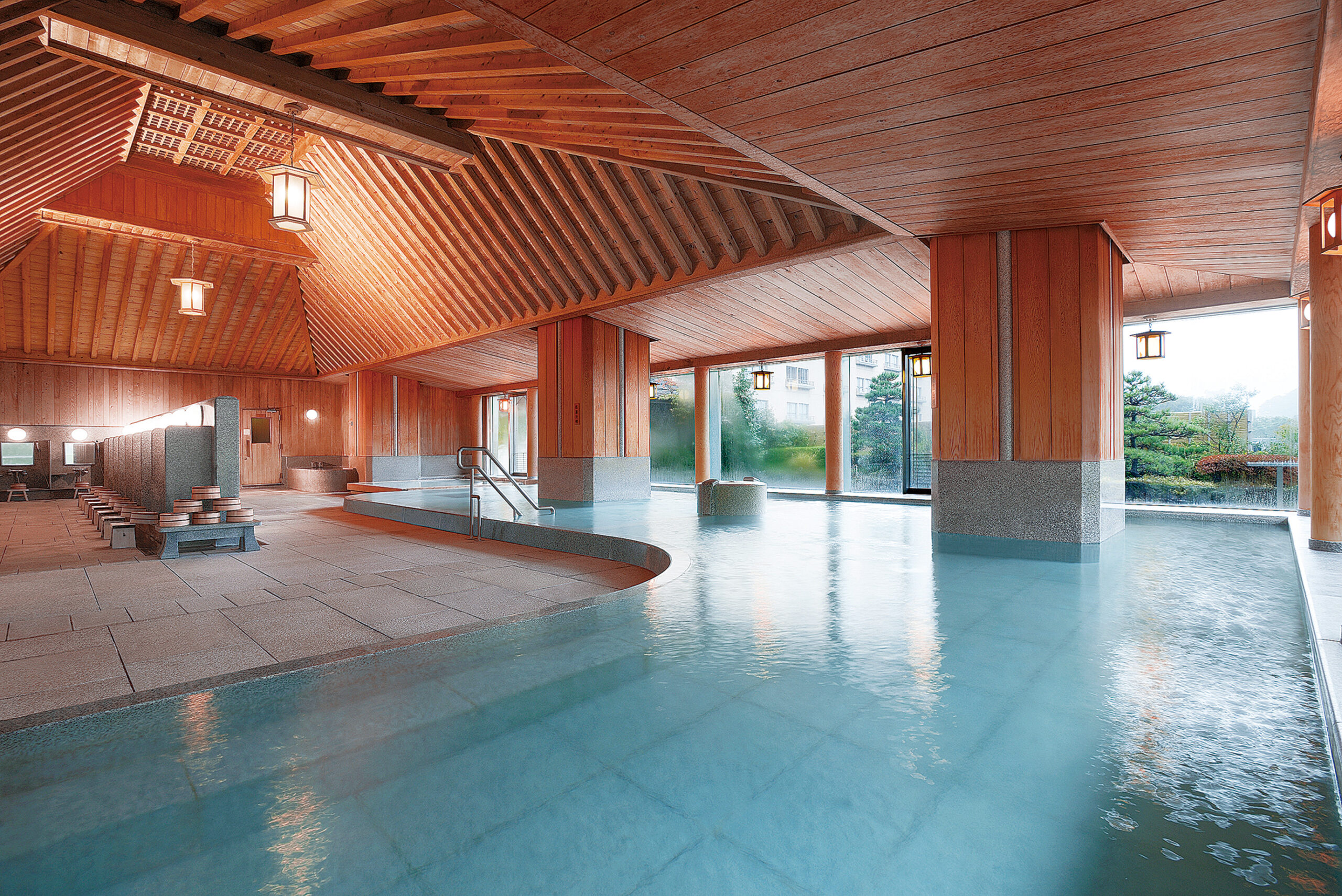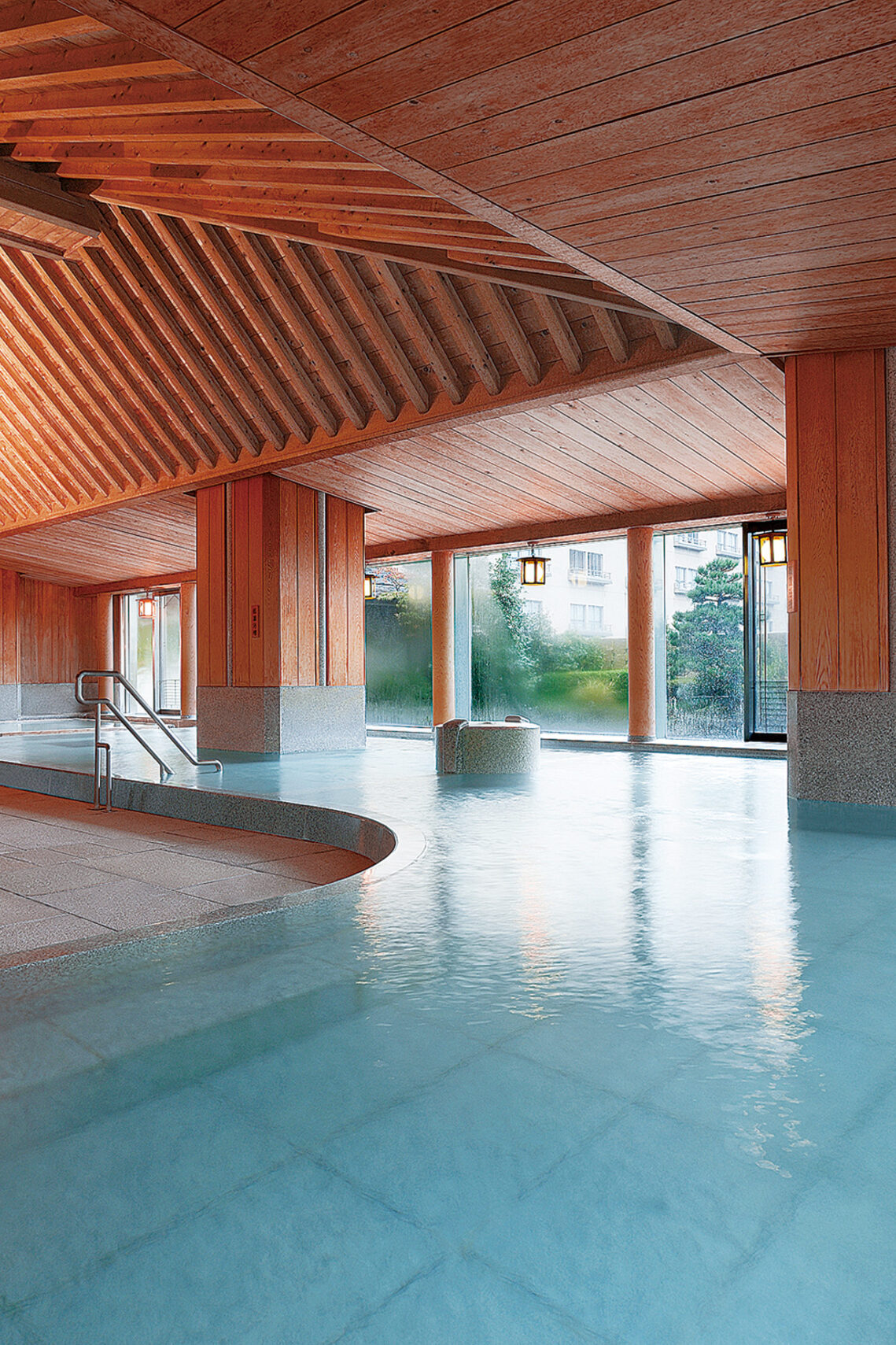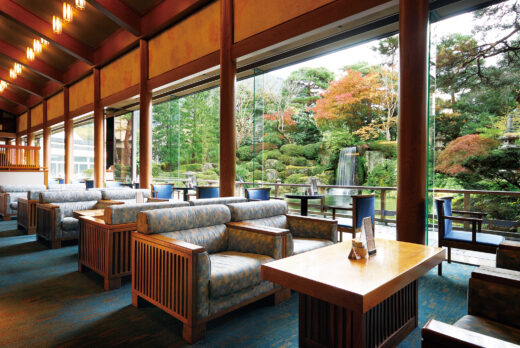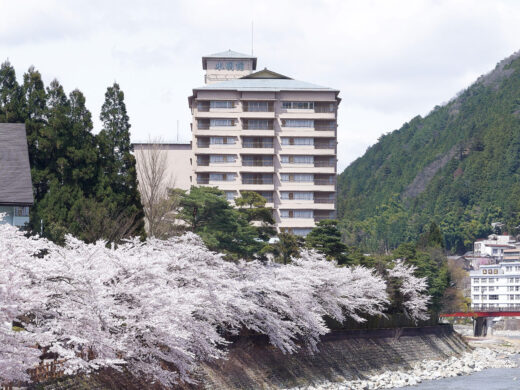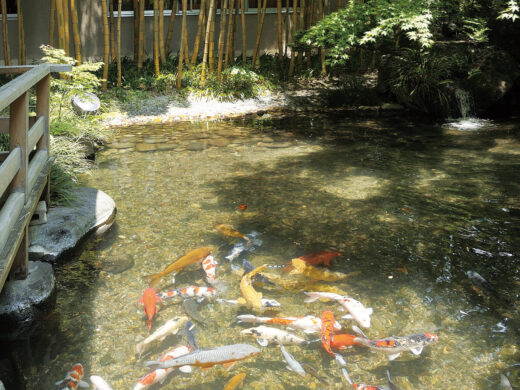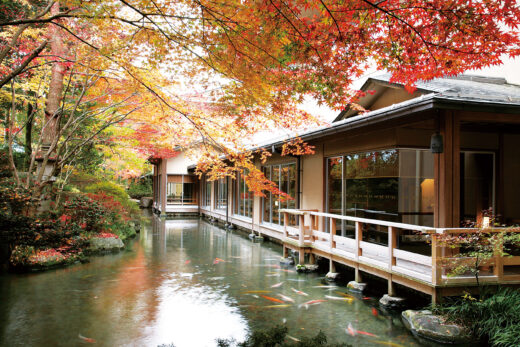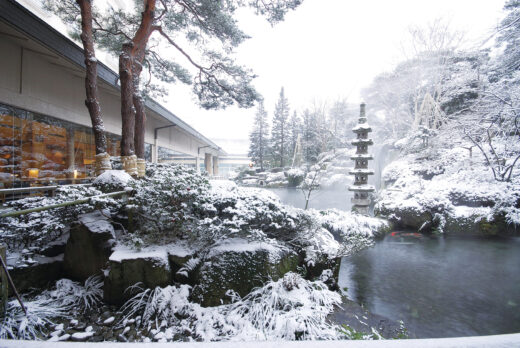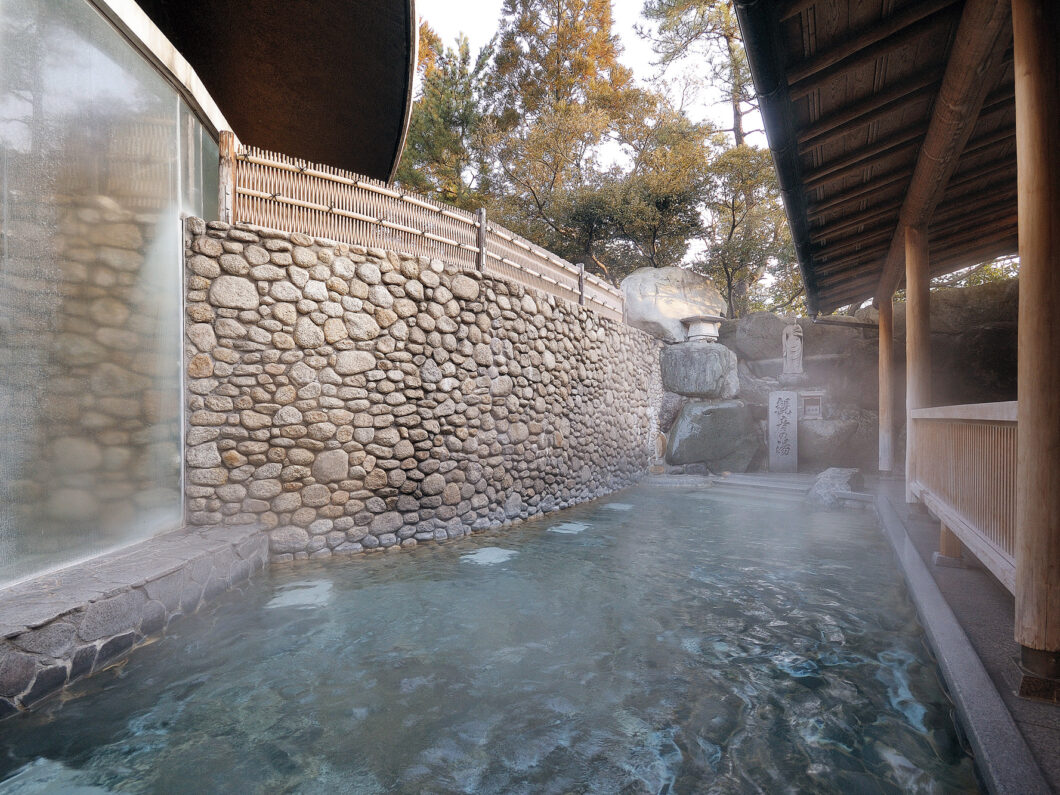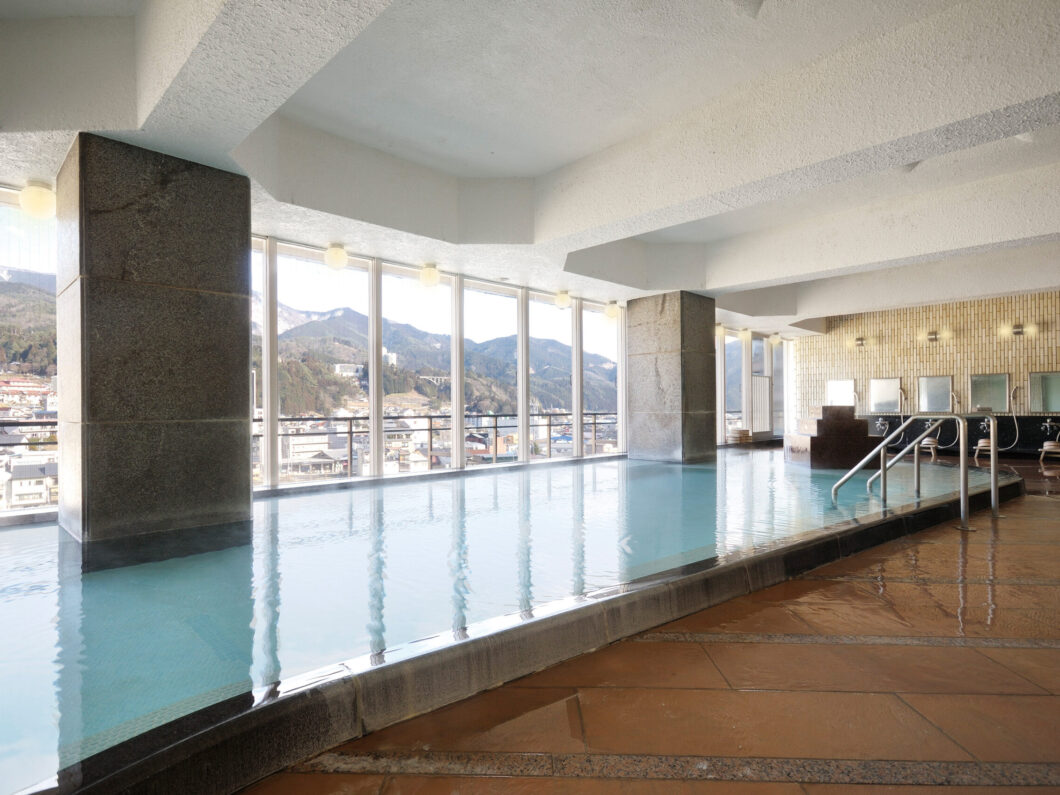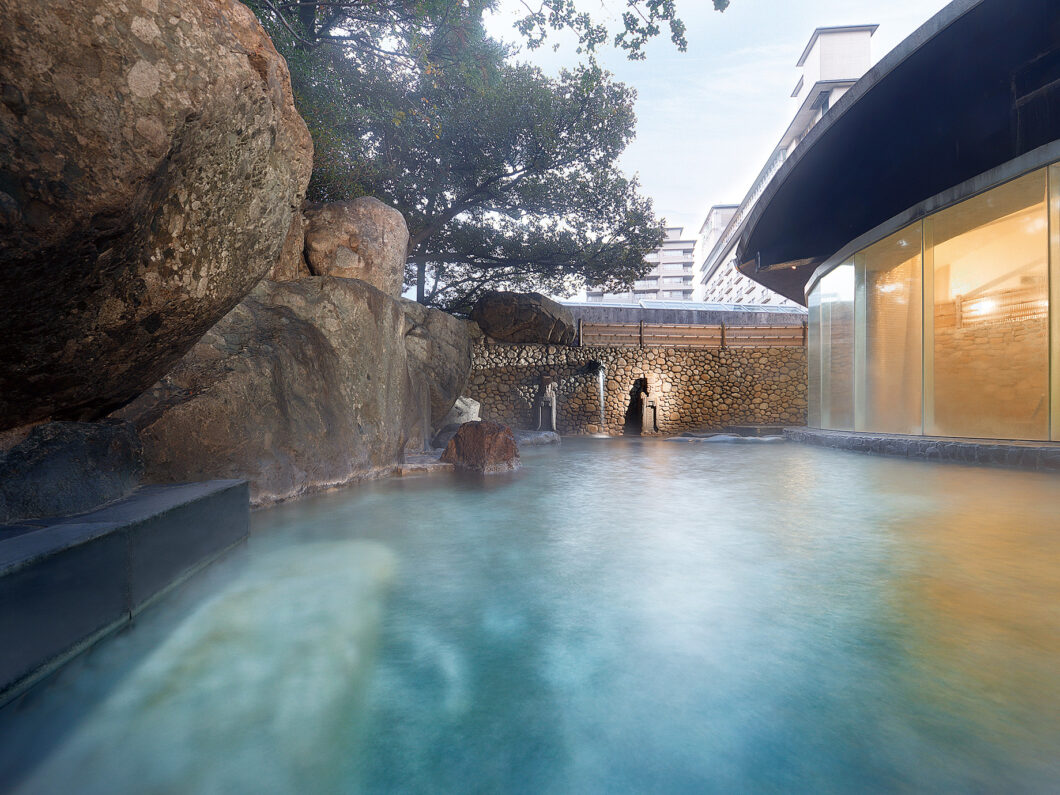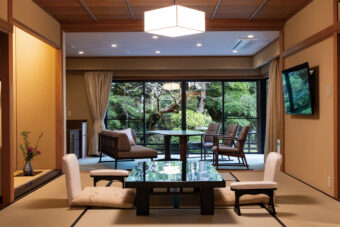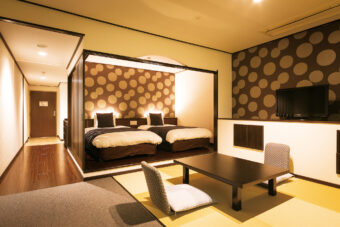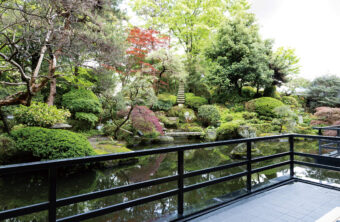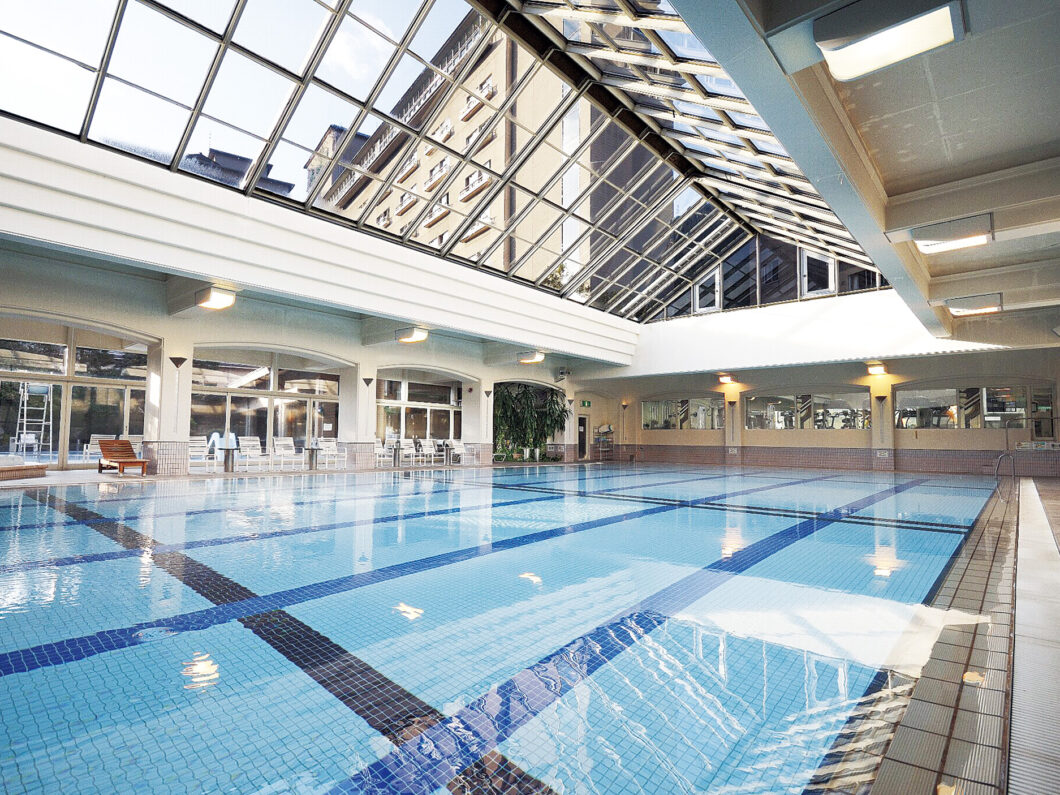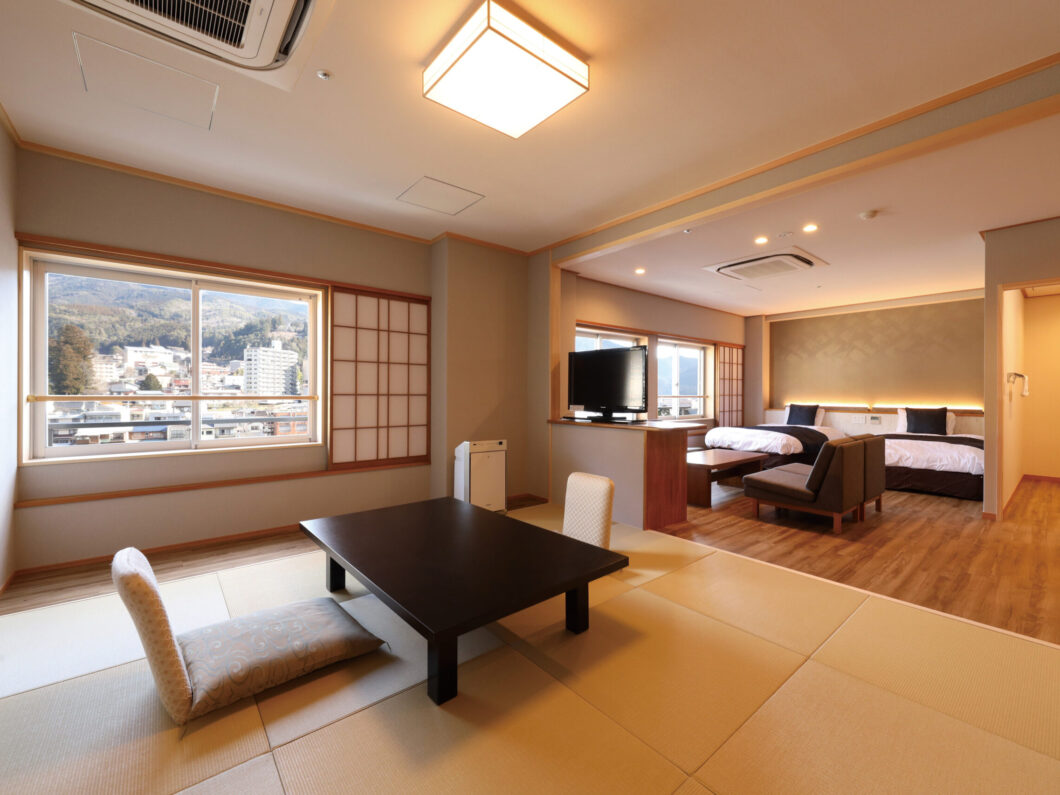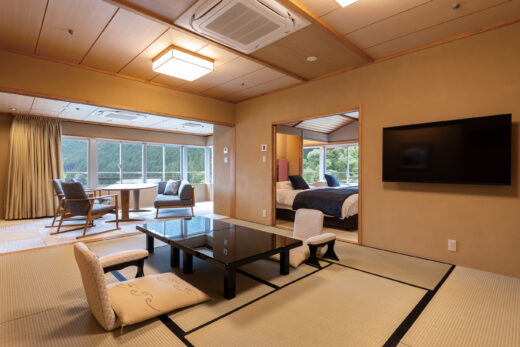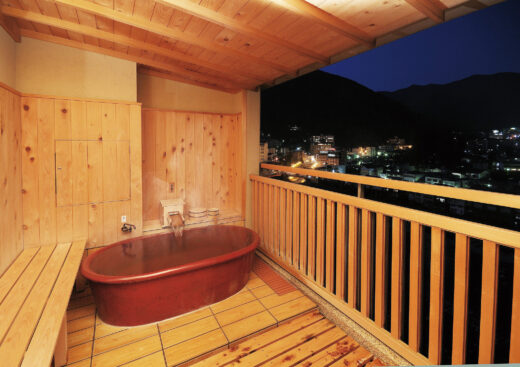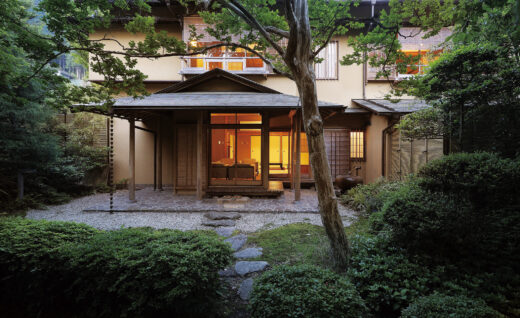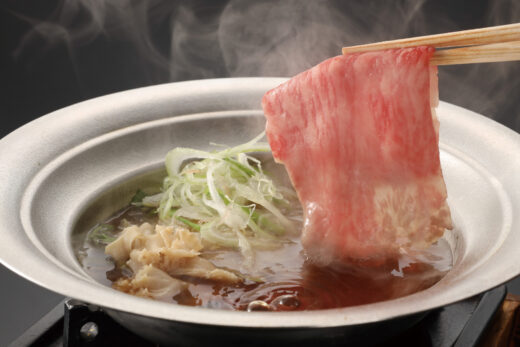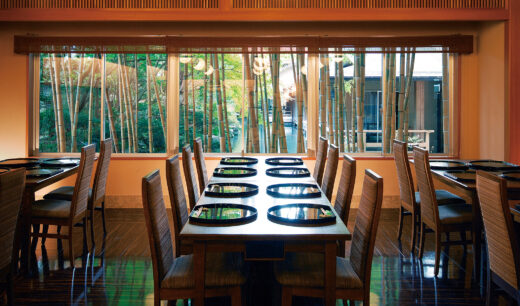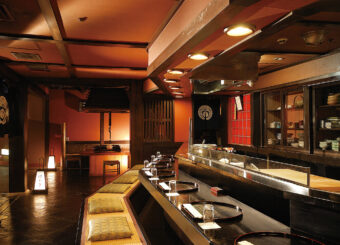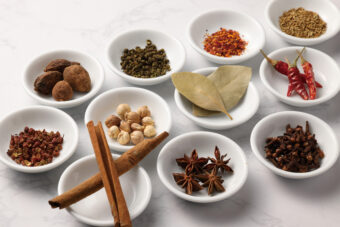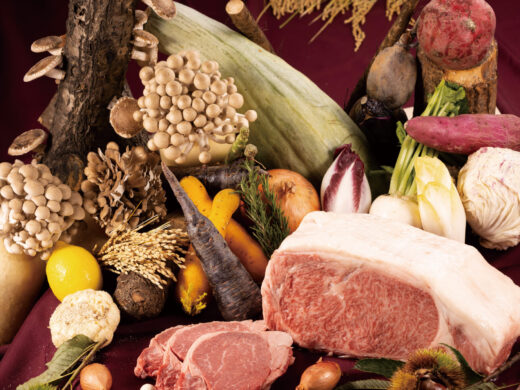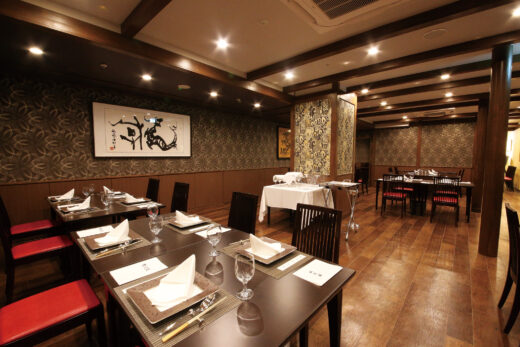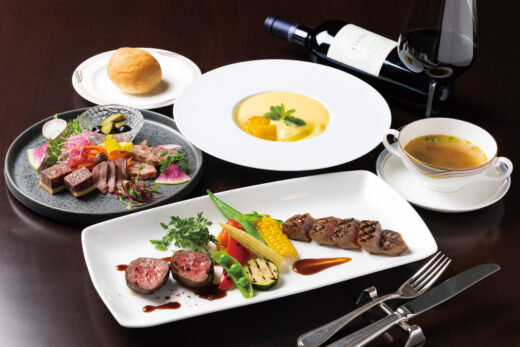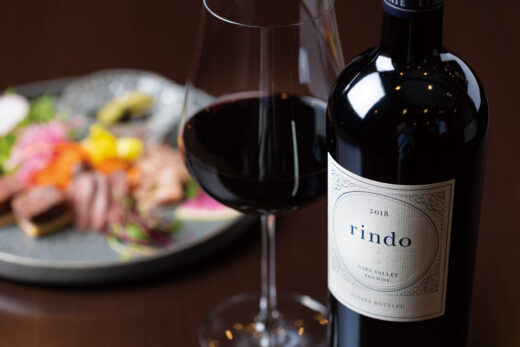Enjoy beauty-enhancing hot springs from one of Japan's three most famous hot springs, a wide variety of guest rooms, and five styles of gourmet cuisine.
Its size and the hospitality it offers are exactly what you'd expect from a traditional Japanese inn.
INDEX
- With beauty-enhancing hot springs from one of Japan's three most famous springs, a wide variety of guest rooms, and five styles of gourmet food, the scale and lineup of hospitality is exactly what you'd expect from a traditional Japanese inn.
- Enjoy the splendor of the "Beauty Bath" in three different types of baths
- Sansuikaku: Relax in a Japanese garden
- Hisenkaku: A building with a global design
- Rinsenkaku: The ultimate space for an elegant stay and enjoying art
- Seiranso: A Cultural Heritage Site in Its Own
- 5 styles of exquisite cuisine and popular game dishes
With beauty-enhancing hot springs from one of Japan's three most famous springs, a wide variety of guest rooms, and five styles of gourmet food, the scale and lineup of hospitality is exactly what you'd expect from a traditional Japanese inn.
Gero Onsen, one of Japan's three most famous Gero Onsen, has a history of over 1,000 years. In the mid-Edo period, the Hishu-shi (Records of Hishu), it is written that "during the Tensho era (947-957), hot springs gushed forth in the mountains of Yunomine, but in 1265, the earth shook violently and the hot springs suddenly stopped flowing, and new hot springs gushed forth on the banks of the Masuda River." A villager wondered about a white heron that flew down to the riverbank every day, and when he went to check it out, he found that the hot springs were gushing forth. Under the pine tree where the white heron had landed, a shining statue of Yakushi Nyorai was enshrined. This is the legend of the white heron passed down in Gero, and the origin of Io-ryozan Onsen-ji Temple, which enshrines this Yakushi Nyorai as its principal image. Yunomine refers to Yuga-mine, located east of the hot spring town, and Masuda-gawa refers to the upper reaches of the Hida River. Currently, the bank of the Hida River is home to the famous "Funsen Pond," which is bustling with people enjoying foot baths.
The oldest record of bathing in Gero Onsen is found in a passage by the Muromachi period Zen monk Banri Shukyu, who wrote that "Gero is one of Japan's three most famous hot springs, along with Kusatsu and Arima." In the Edo period, the Confucian scholar Hayashi Razan, who served the fourth Tokugawa shogun, also praised Kusatsu, Arima, and Gero as three of the most famous hot springs, which caused the name of Gero Onsen to suddenly become known throughout the country. Even during the Edo period, when transportation networks were underdeveloped, Gero Onsen was said to have already attracted as many as 30,000 people a year for its hot spring cures. Its name also appears in the "Hot Springs Rankings of Various Provinces" from the late Edo period. This historical fact gives us an idea of just how attractive the hot springs were. Today, statues of Shukyu and Razan welcome tourists on Shirasagi Bridge.
The lobby lounge "Evian" is decorated with a single Zelkova pillar and natural Hida wood. You can relax while looking out at the Japanese garden, which changes with the seasons.
Across the Ideyu Bridge from Suimeikan, in a corner of the hot spring town, close to Onsenji Temple, is the Gero Onsen Museum, which introduces hot springs from both the scientific and cultural perspectives. It's the perfect tourist spot to learn about the wonders of hot springs.
Gero Onsen is an alkaline simple spring. The thick, slippery water with a high concentration of alkaline components at pH 9.4 is widely known as a "beauty bath."Suimeikan, one of Japan's leading inns offering classic hospitality, is also famous as a "hot spring resort filled with beauty baths," attracting many bathers throughout the year.
Enjoy the splendor of the "Beauty Bath" in three different types of baths
Suimeikan boasts a convenient location for sightseeing, just a three-minute walk from Gero Station. The four buildings, from the road side, are the five-story Sansuikaku, the nine-story Hisenkaku, the twelve-story Rinsenkaku, and the detached Seiranso. Equipped with a variety of facilities that will have you surrounded by the colors of the season whenever you visit, the hotel promises an exceptionally fulfilling stay, with high-quality guest rooms and five styles of gourmet food to choose from depending on the plan. You will also be deeply comforted by the warmth of this long-established inn, which has been in business since 1932 and continues to offer hospitality. The name of the inn, "Suimeikan," was taken from a description of the scene when the hot spring drilling was successful, describing it as "steam rising from the water." As the saying goes, the hot springs that everyone praises provide a wonderful time of relaxation.
The large hot spring baths are the "Observation Bath" on the 9th floor of Hisenkaku, the "Shimodome no Yu" on the 3rd floor of Rinseikaku, and the "Open-air Bath" on the 1st floor of Sansuikaku, with the "Ryujin no Yu" for men and the "Kannon no Yu" for women. All of the baths are filled with unheated natural alkaline simple spring water. When female guests are asked about their impressions, they respond with comments such as "It's a strange sensation, like the thick water clings to your skin and your skin repels the water," "It's slimy, but your skin feels refreshed after a bath," and "It's like lotion." Some people say that their dry skin improved after just one bath during the dry season. Your skin will tell you why this hot spring is one of the three famous springs.
The most popular bath is Shimodome-no-Yu at Rinsenkaku. The luxurious interior, with its ceilings, walls and pillars made of cypress, is spacious enough for groups to enjoy, as well as hot and cold baths and a sauna. Stretch your limbs while the scent of the hot water and cypress relieves your body and mind... It's a moment of utmost bliss. On the fourth floor of Rinsenkaku, there are two private hot spring baths with 100% natural hot spring water, and you can also enjoy a bedrock bath using four types of natural minerals. The Observation Bath at Hisenkaku is available 24 hours a day, and from the large bath overflowing with hot spring water, you can enjoy the view of the Gero mountain range during the day and the twinkling lights of Gero town at night. Sharing this view is the beauty salon Salon de Clair next to the bath. The décolleté course, which loosens the shoulder blades, which are prone to fatigue, and cares for the neck pillar, is very popular. Recommended for women is the "Clay Plan," which absorbs dirt and waste from the skin, leaving it brighter. Beauty treatments are also available for women only, and require a reservation. Both men and women can use the oxygen capsule, which is effective for relieving stiff shoulders, back pain, and fatigue. In addition, at Sansuikaku's "Open Air Bath," you can enjoy the true essence of hot springs while feeling the light and breeze of Hida. The atmosphere as the twilight turns to night is irresistible. In the early morning, you can wake up refreshed with a bath to the sounds of wild birds chirping.
Sansuikaku: Relax in a Japanese garden
At Suimeikan, where you can feel the tradition of Suimeikan, the special rooms with a hot spring bath are ever-popular. The garden viewed from the purely Japanese-style space is considered "my garden." While gazing at the garden, you can focus on the colors of the trees and the coming of the breeze... This is how to enjoy a Japanese inn. In December 2023, three special rooms with indoor hot spring baths with hot spring water will be reopened. The space retains the warmth of the good old days, and the veranda features Hida furniture made by Hida craftsmen. You can enjoy a luxurious stay where you can have the hot spring water all to yourself while looking out at the beautiful Japanese garden that looks like a painting. On the 4th and 5th floors overlooking the garden, there are 10 stylish Japanese-Western rooms with hot spring baths that meet the individual needs of each guest. The step-free space, designed for a wide range of guests, has a woody interior that blends in with the nature of Hida, inviting you to a deep slumber. There is a closet, so you can enjoy long-term stays.
Sansuikaku "Special Room." A view of the green garden from the tatami room. A sense of tranquility permeates the air.
Sansuikaku's "New Japanese-Western Room." The room is fitted with a double bed for a relaxing stay, and there are few steps so you can relax in peace.
On the first floor where the open-air bath is located, Suimei Health Club is equipped with an athletic gym and a hot spring pool. In 2016, it was certified as a "designated exercise therapy facility" by the Ministry of Health, Labor and Welfare, and in October 2023, it will also be certified as a "hot spring-based health promotion facility" that meets certain standards set by the Ministry of Health, Labor and Welfare and can promote health using hot springs. If you use Suimei Health Club for hot spring therapy and meet the requirements, you can receive a medical expense deduction from your income tax for the facility usage fee and transportation to and from the facility.
Hisenkaku: A building with a global design
Check-in and check-out at Suimeikan are at 2 p.m. and 11 a.m., respectively. The great thing about this Suimeikan is that you can spend 21 hours as you like. Hisenkaku has the entrance and front desk. With a front desk, an authentic Japanese garden, and a lobby lounge, it combines the best of both Western and Japanese culture, and is located between Rinsenkaku and Sansuikaku, making it easy to move around the building. A variety of guest rooms are available on the 3rd to 8th floors, but recent renovations have created global design rooms where everyone can stay with peace of mind. The 14 Japanese-Western rooms on the 6th floor, which were renovated and reopened in 2022, are warm spaces that incorporate Hida wood, and along with the Japanese-Western rooms on the 7th floor, they are light-filled and have few steps. The Hida region is a place where advanced woodworking techniques are still passed down to the present day. The Japanese-Western rooms on the 7th floor are furnished with furniture made by modern master craftsmen, and the beautiful texture and warmth of the wood softly accentuate the atmosphere of the light-filled space.
There are five special rooms on the eighth floor. The entire building is flat from the entrance, making it a stress-free space for children, the elderly, and wheelchair users. The rooms, which consist of eight tatami mat rooms, a Western-style room, twin beds, and a work desk, also meet the needs of workation. While relaxing in the private space and hot springs, you can also keep in touch with the front lines of business.
Rinsenkaku: The ultimate space for an elegant stay and enjoying art
A work called "Mountain Thoughts" is displayed in the escalator hall that connects Hisenkaku to the second floor of Rinsenkaku. It is a masterpiece by Kato Kobei, the seventh generation of Kobeigama, and is a masterpiece with an elegant atmosphere with Mt. Ontake in Gifu Prefecture in the background. On the far left wall of the second floor is a vivid Persian blue tile mural called "Resting in Izumigo" by his father, the sixth generation Living National Treasure Kato Takuo. It is a reproduction of luster color, which is said to have disappeared in the 16th and 17th centuries. Both works are worthy of being in a museum. The value of the art and crafts has been transformed, adding dignity and calm to the space. At Rinsenkaku, you can also enjoy a full-scale Noh stage supervised by Kanze school Noh actor Shoroku Sekine. A stay at Rinsenkaku is a time to relax and enjoy art and culture.
Overview of artworks in the museum
Art gallery "Taikan no Ma" - ceramic artist Kato Kobei's masterpiece "Mountain Thoughts" - "Living National Treasure ceramic artist Kato Takuo's tile mural "Thinking of Izumikyo" - Nakajima Chinami's masterpiece "Garyuu Sakura in Full Bloom" - Naganawa Shiro's painting "Autumn" - calligraphy by Yamada Mumon, 26th head priest of the Myoshinji school, "Today is Safe" - Kanze school Noh actor Shouroku Sekine's authentic Noh stage "Ishibashi no Ma" - Special Natural Monument "Kikuka-ishi" - Tea house "Suikoan" supervised by 15th head of the Urasenke school Sen Soshitsu - The curtain of the "Spring and Autumn Room" produced by Kyoto Tatsumura Art Textiles based on Naganawa Shiro's painting "Colors of the Seasons"
Rinsenkaku, decorated with traditional Japanese beauty, is the most elegant space in Suimeikan. The rooms are also beautifully furnished and spacious. The charm of the hotel is that all the rooms on the 5th to 12th floors are equipped with indoor hot spring baths and balconies with great views. There are four rooms with open-air baths on the 10th and 11th floors, with floor plans of 12.5 tatami mats and 6 tatami mats. The open-air bath and indoor bath are free-flowing from the source, and the indoor bath is rich in alkaline water, which blends well with the water. The bath space is made entirely of cypress. The VIP rooms "Horai" and "Wago" on the top floor, the 12th floor, are luxurious spaces of 210 square meters with a bedroom, living room, and marble bath, and have welcomed the Emperor and prime ministers in the past. In May 2024, the 12th floor will be renovated into an executive suite. Rinsenkaku also has Japanese-style rooms and Japanese-Western rooms. All of them have the same high-quality feel. Depending on the angle, some rooms even offer views of the Hida River fireworks (held irregularly).
All meals are served in the comfort of your own room, in the tatami-mat rooms. The head chef, who was appointed head chef at a high-class restaurant in Kyoto at a young age and has received numerous awards, including the Minister of Health, Labor and Welfare Award, creates Japanese cuisine that exudes the elegance of Kyoto. Carefully selected seasonal ingredients are used in a variety of colorful dishes that are a feast for the eyes and the tongue. Gourmets will be thrilled by the seasonal kaiseki course menu and the famous Hida beef shabu-shabu. All dishes are of the finest quality.
A special room on the top floor of Rinsenkaku, which was renovated and reopened in April 2024. It features a Japanese-Western style room, a wide veranda, a balcony, and an indoor hot spring bath.
Seiranso: A Cultural Heritage Site in Its Own
In one corner of the Japanese garden stands the detached building "Seiransou", a restored Sukiya-style building that was established as an inn in 1953. It was named by the leading figure in the Japanese art world, Kawai Gyokudō. His calligraphy hangs directly in front of the entrance. The building has tatami corridors. There are two rooms on the first floor with an open-air bath surrounded by trees and rocks and an indoor hot spring bath made of Japanese cedar, and three rooms on the second floor with an indoor hot spring bath and hot spring floor heating. You can enjoy a traditional stay surrounded by the gentleness of the trees that reflect the four seasons of Japan. What you should see are the magnificent designs, such as the Kyoto Karakami hand-painted woodblock prints and door handles that are named after the rooms, and the openwork carvings of the scent symbols "Genji Kozu (red plum, hollyhock, bamboo river, evening laurel, oak)" that are named after the 54th chapter of the Tale of Genji. The fittings are changed with the seasons. It is a cultural heritage that we would like to continue to treasure and protect. Meals are "in-room dining" for a peaceful stay. The executive chef prepares a variety of specially prepared dishes using carefully selected ingredients procured that day, allowing you to enjoy a blissful moment as you leisurely savor the seasonal colors with your eyes and tongue.
5 styles of exquisite cuisine and popular game dishes
Suimeikan offers five dining styles: Japanese, Hida local cuisine, French, Chinese, and Japanese-Western fusion cuisine. When talking about Japanese lodging culture, in-room dining is a staple. The taste, which makes the most of the natural flavors of the ingredients and is based on the five tastes, five colors, and five methods, is the very essence of Japanese cuisine. The knife skills of the head chef, who honed his skills at a Kyoto restaurant, the selection of tableware, and the presentation are all impressive. At Ryori-chaya Kitano-ryo, you can enjoy kaiseki cuisine made with seasonal Hida ingredients while relaxing in a private tatami room and feeling the nostalgia of Hida. The dishes, which are made with seasonal ingredients such as the specialty Hida beef and Hida natto-eating pork, as well as wild vegetables and mushrooms, are also excellent. You can also sit around the hearth, which would go well with local sake.
Kitano Ryo is a nostalgic restaurant that serves course meals featuring seasonal mountain delicacies, including Gifu wild game.
Japanese cuisine (image) that is carefully hand-prepared, making the most of the natural flavors of seasonal ingredients, and focusing on the five tastes, five colors, and five methods.
European Restaurant Baden Baden welcomes you with a relaxed atmosphere and authentic cuisine. We recommend the "Sommelier Selected Dinner Pairing Hida Ingredients with Wine by the Glass." The chef carefully grills the Hida beef loin to perfection. They also offer special events for birthdays and anniversaries. Their Chinese cuisine is beyond imagination. At China Room Long Yuri, you can enjoy a new style of Chinese cuisine, "Nouvelle Chinois." Each dish is beautifully presented, based on Cantonese cuisine and focusing on the flavor of the ingredients. At Dining Tokiwa, where the chefs are enthusiastic, you can enjoy freshly prepared dishes delivered from both the Japanese and Western open kitchens. For breakfast, you can enjoy about 30 types of Japanese and Western dishes, including French toast made with Hida milk and local eggs.
Hida beef and local vegetables (image). In particular, the vegetables are fresh and organically grown with almost no pesticides, making the most of the semi-highland environment.
Suimeikan, a Gifu Gibier member restaurant, also offers plans with various gibier dishes, which are a hot topic. At Kita no Ryo, they offer a plan using sweetfish and Japanese deer, at Baden Baden, they offer a plan to taste Hida beef and venison, and at Ryuyuri, they offer a medicinal hot pot plan using plenty of venison. They also use the premium wine "Kenzo Estate" from Napa Valley, which has many die-hard fans around the world. It goes perfectly with gibier dishes. It can be enjoyed at all restaurants. At the lounge, Evian, the "Japanese Afternoon Tea" featuring local Japanese sweets and desserts is also popular. Suimeikan also offers a gourmet plan with a hot spring bath, which is perfect for sightseeing in Gero city. At Kita no Ryo, you can enjoy the "Hida Beef Hitsumabushi Zen," at Baden Baden, the "Hida Beef Premium Hamburger Set," and at Evian, the "Gero Choux."Suimeikan is full of endless charms. Add in a variety of special experiences to enjoy Gero and you'll have a special holiday.
Hida beef and gibier (image). Gibier dishes made from wild boar and Japanese deer caught in Gifu Prefecture are low in fat and rich in protein and iron.
More Information
| building | Hisenkaku: 9-story reinforced concrete building, Sansuikaku: 5-story reinforced concrete building, Rinsenkaku: 12-story reinforced concrete building, Seiranso: 2-story wooden building |
|---|---|
| Rooms | (Total 264 rooms) / 137 Japanese-style rooms, 26 Western-style rooms, 101 Japanese-Western style rooms (6 of which have open-air baths) |
| meal | Dinner: Japanese, Western, Chinese; Breakfast: Japanese, buffet |
| Facilities | Baths: Large public bath, open-air bath, panoramic large public bath, private hot spring bath, bedrock bath, banquet hall (23 rooms, 10 to 500 tatami mats), convention hall (800 people), restaurant (1 room), restaurant (250 seats), karaoke (5 rooms), club, bar, tea lounge, games, shop, beauty salon, wedding hall, Suimei Health Club (gym, indoor hot spring pool & summer pool) |
| Fee | 19,800 yen - 99,000 yen (tax included, bathing tax not included) |
| Check-in and check-out | Check-in: 14:00 Check-out: 11:00 |
| Wifi | The whole building |
| Smoking and non-smoking | No smoking in the entire building, smoking rooms available |
| Hot spring quality | Alkaline simple spring (pH 9.30) |
Facility information / Access
| location | 1268 Koda, Gero City, Gifu Prefecture, 509-2206 |
|---|---|
| Railway | Get off at Gero Station on the JR Takayama Main Line, then walk for about 3 minutes |
| car | From Nakatsugawa IC on the Chuo Expressway, take Route 257, approximately 55km |
| plane | About 150 minutes by taxi from Chubu Centrair International Airport |
| parking | 200 passenger cars and 20 large vehicles |
| Shuttle bus | From Gero Station |
| TEL | 0570–07-2800 |
| FAX | 0576-25-4520 |
| URL | https://www.suimeikan.co.jp |


